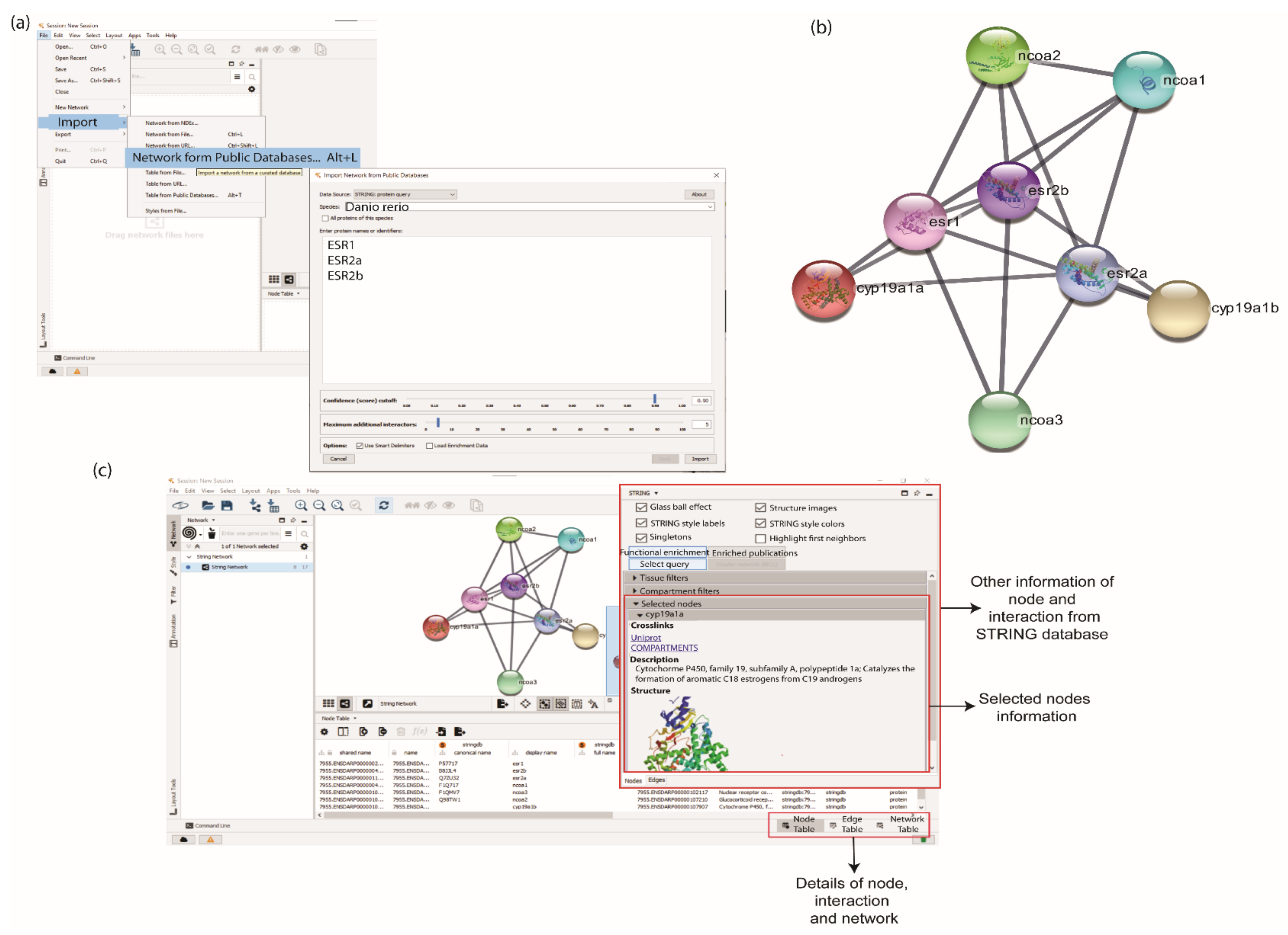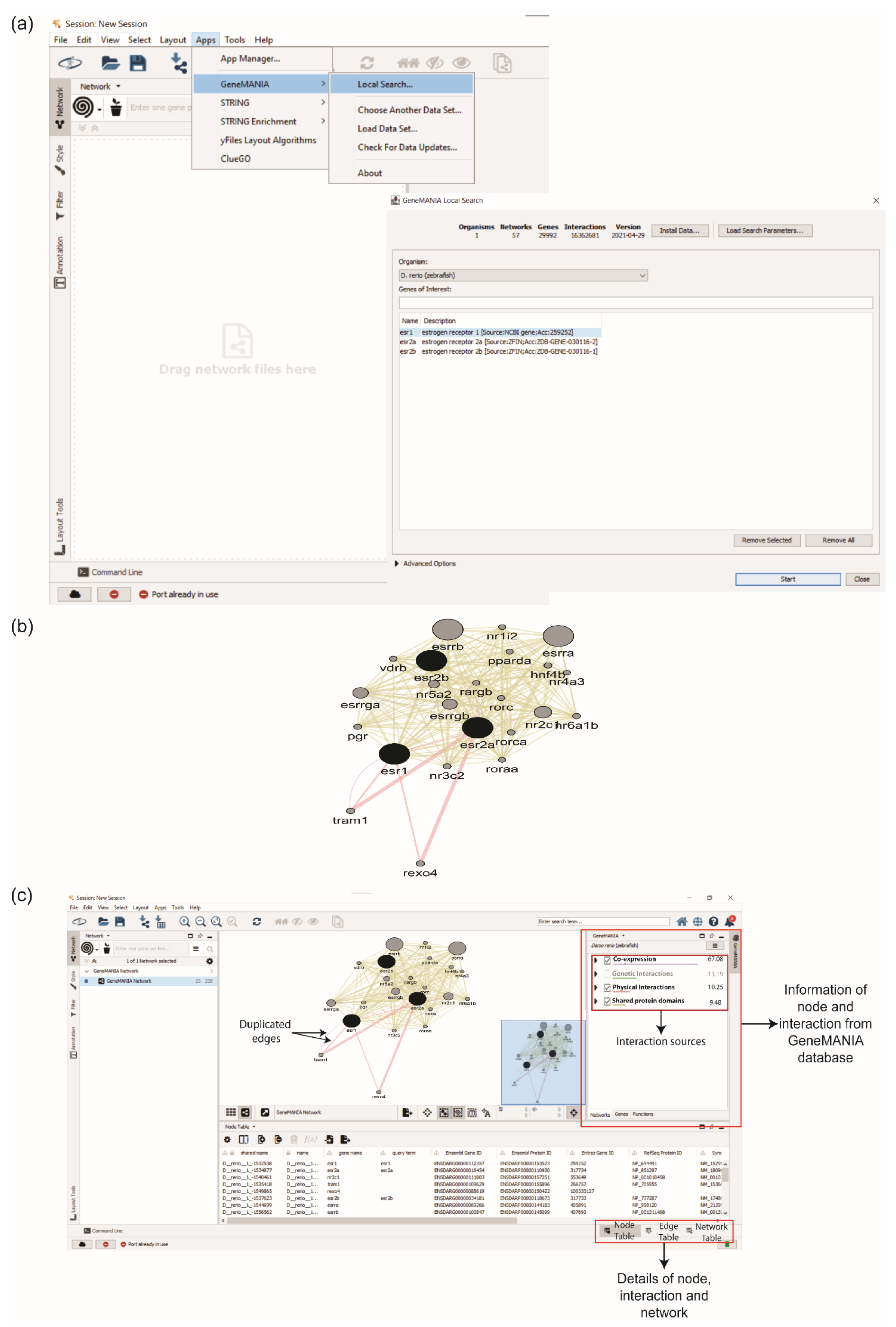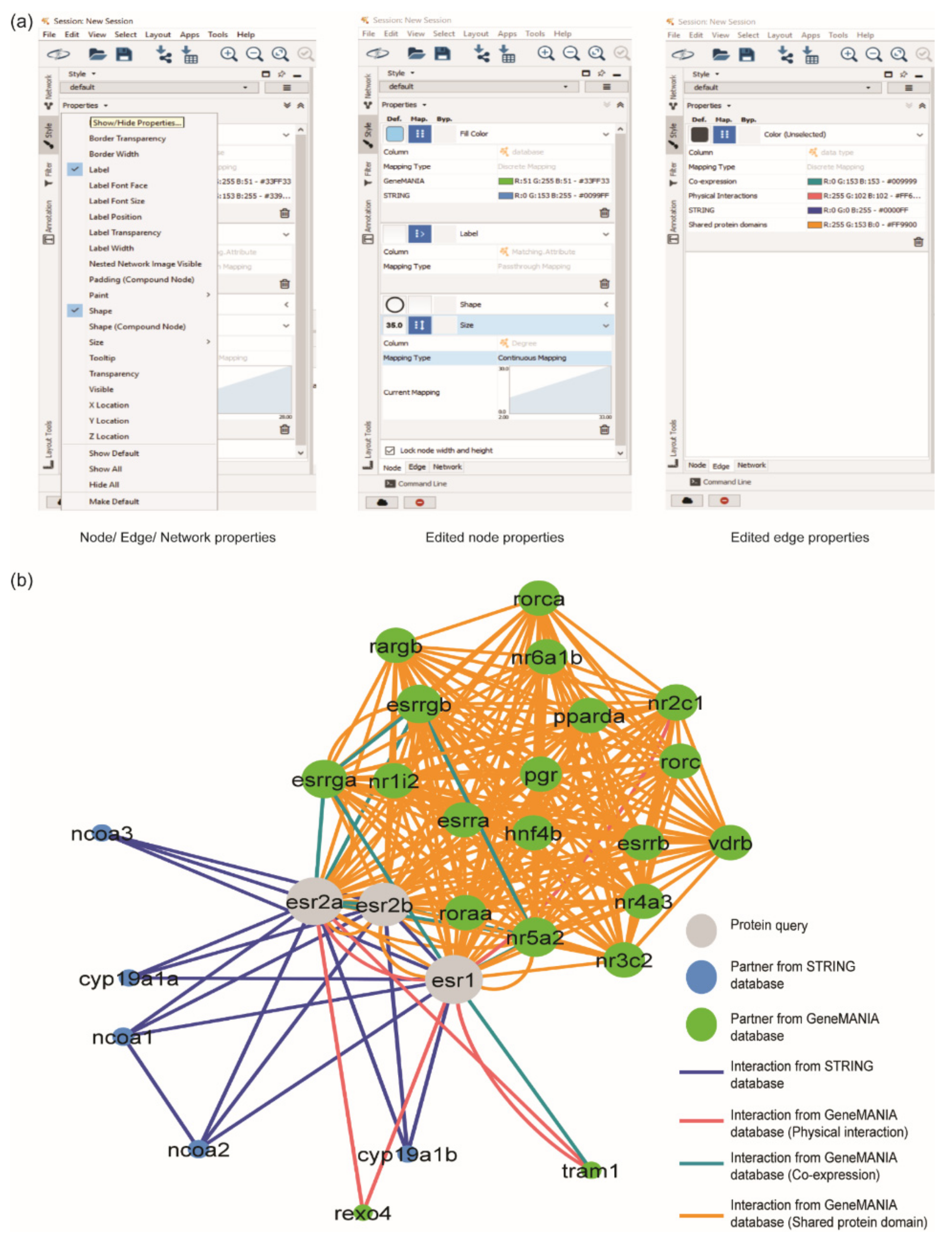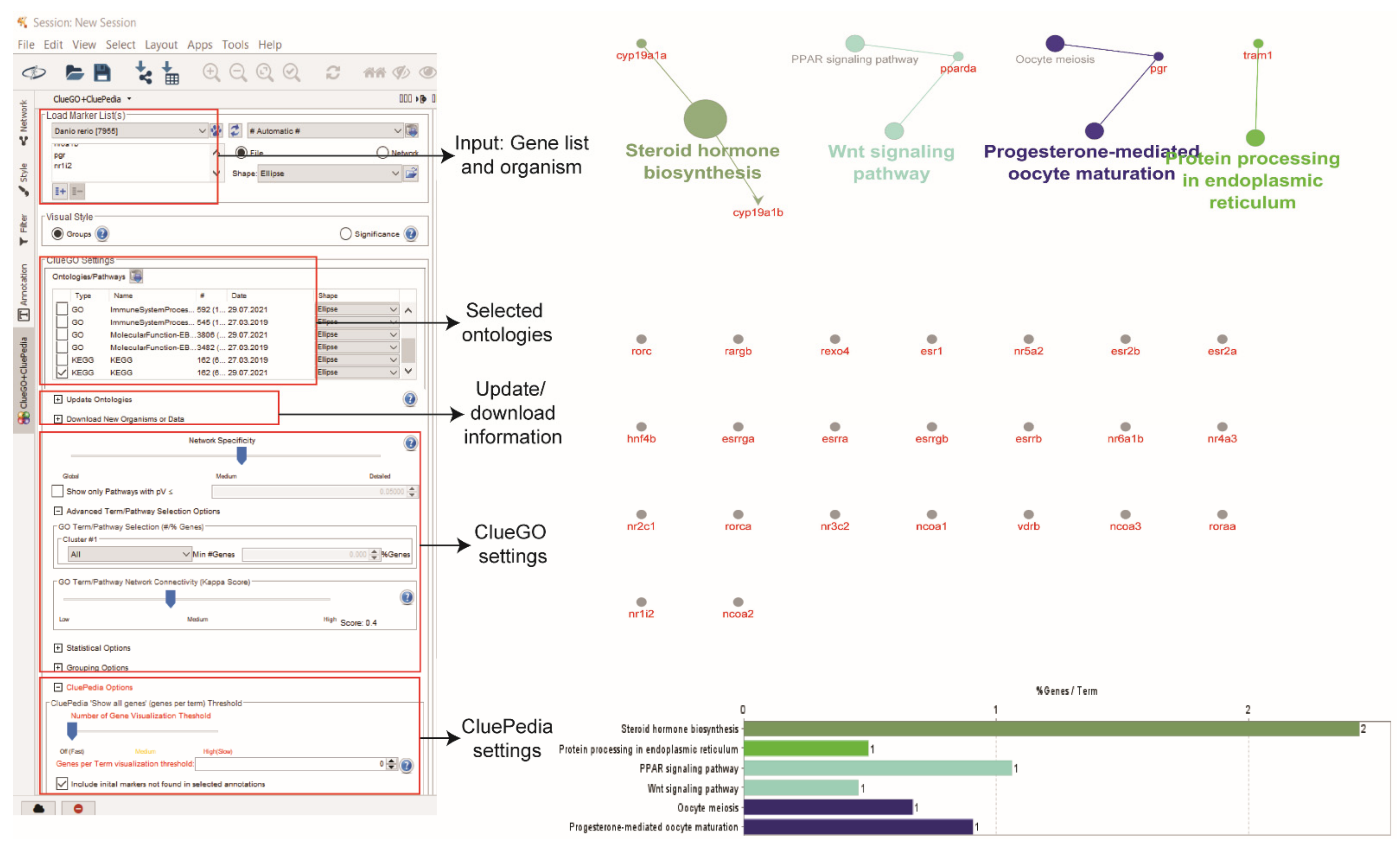Protein–Protein Interaction (PPI) Network of Zebrafish Oestrogen Receptors: A Bioinformatics Workflow
Abstract
1. Introduction
1.1. Protein–Protein Interaction (PPI)
1.2. Protein–Protein Interaction Databases
2. Bioinformatics Workflow for Protein–Protein Interaction Network
2.1. Network Construction and Visualisation Platform Using Cytoscape
2.2. Retrieving PPIs of Oestrogen Receptors (ERs) from Public PPI Databases
2.3. PPI Networks Integration
2.4. Editing PPI Network Style
2.5. Functional Analysis
3. Discussion and Future Direction
4. Conclusions
Supplementary Materials
Author Contributions
Funding
Institutional Review Board Statement
Informed Consent Statement
Data Availability Statement
Acknowledgments
Conflicts of Interest
References
- Manzoni, C.; Kia, D.A.; Vandrovcova, J.; Hardy, J.; Wood, N.W.; Lewis, P.A.; Ferrari, R. Genome, transcriptome and proteome: The rise of omics data and their integration in biomedical sciences. Brief. Bioinform. 2018, 19, 286–302. [Google Scholar] [CrossRef] [PubMed]
- Ideker, T.; Krogan, N.J. Differential Network Biology. Mol. Syst. Biol. 2012, 8, 565. [Google Scholar] [CrossRef] [PubMed]
- Luck, K.; Kim, D.K.; Lambourne, L.; Spirohn, K.; Begg, B.E.; Bian, W.; Brignall, R.; Cafarelli, T.; Campos-Laborie, F.J.; Charloteaux, B.; et al. A reference map of the human binary protein interactome. Nature 2020, 580, 402–408. [Google Scholar] [CrossRef] [PubMed]
- Fessenden, M. Protein maps chart the causes of disease. Nature 2017, 549, 293–295. [Google Scholar] [CrossRef] [PubMed]
- Waiho, K.; Afiqah-Aleng, N.; Iryani, M.T.M.; Fazhan, H. Protein-protein interaction network: An emerging tool for understanding fish disease in aquaculture. Rev. Aquac. 2021, 13, 156–177. [Google Scholar] [CrossRef]
- Ding, Z.; Kihara, D. Computational identification of protein-protein interactions in model plant proteomes. Sci. Rep. 2019, 9, 8740. [Google Scholar] [CrossRef]
- Rao, V.S.; Srinivas, K.; Sujini, G.N.; Kumar, G.N.S. Protein-protein interaction detection: Methods and analysis. Int. J. Proteom. 2014, 2014, 147648. [Google Scholar] [CrossRef]
- Bauer, A.; Kuster, B. Affinity purification-mass spectrometry. Powerful tools for the characterization of protein complexes. Eur. J. Biochem. 2003, 270, 570–578. [Google Scholar] [CrossRef]
- Wong, J.H.; Alfatah, M.; Sin, M.F.; Sim, H.M.; Verma, C.S.; Lane, D.P.; Arumugam, P. A yeast two-hybrid system for the screening and characterization of small-molecule inhibitors of protein-protein interactions identifies a novel putative Mdm2-binding site in p53. BMC Biol. 2017, 15, 108. [Google Scholar] [CrossRef]
- Zhang, X.; Fei, D.; Sun, L.; Li, M.; Ma, Y.Y.; Wang, C.; Huang, S.; Ma, M. Identification of the novel host protein interacting with the structural protein VP1 of Chinese sacbrood virus by yeast two-hybrid screening. Front. Microbiol. 2019, 10, 2192. [Google Scholar] [CrossRef]
- Fields, S.; Song, O. A Novel Genetic System to Detect Protein-Protein Interactions. Nature 1989, 340, 245–246. [Google Scholar] [CrossRef] [PubMed]
- Swamy, K.B.S.; Schuyler, S.C.; Leu, J.Y. Protein complexes form a basis for complex hybrid incompatibility. Front. Genet. 2021, 12, 609766. [Google Scholar] [CrossRef] [PubMed]
- Ramos, P.I.P.; Arge, L.W.P.; Lima, N.C.B.; Fukutani, K.F.; de Queiroz, A.T.L. Leveraging User-friendly network approaches to extract knowledge from high-throughput omics datasets. Front. Genet. 2019, 10, 1120. [Google Scholar] [CrossRef] [PubMed]
- De Las Rivas, J.; Fontanillo, C. Protein-protein interactions essentials: Key concepts to building and analyzing interactome networks. PLoS Comput. Biol. 2010, 6, e1000807. [Google Scholar] [CrossRef]
- Harun, S.; Zulkifle, N. Construction and analysis of protein-protein interaction network to identify the molecular mechanism in laryngeal cancer. Sains Malays. 2018, 47, 2933–2940. [Google Scholar] [CrossRef]
- Liu, L.; He, C.; Zhou, Q.; Wang, G.; Lv, Z.; Liu, J. Identification of key genes and pathways of thyroid cancer by integrated bioinformatics analysis. J. Cell. Physiol. 2019, 234, 23647–23657. [Google Scholar] [CrossRef]
- Afiqah-Aleng, N.; Altaf-Ul-Amin, M.; Kanaya, S.; Mohamed-Hussein, Z.-A. Graph cluster approach in identifying novel proteins and significant pathways involved in polycystic ovary syndrome. Reprod. Biomed. Online 2020, 40, 319–330. [Google Scholar] [CrossRef]
- Tang, X.; Hu, X.; Yang, X.; Fan, Y.; Li, Y.; Hu, W.; Liao, Y.; Zheng, M.c.; Peng, W.; Gao, L. Predicting diabetes mellitus genes via protein-protein interaction and protein subcellular localization information. BMC Genom. 2016, 17, 433. [Google Scholar] [CrossRef]
- Tan, X.; Zhang, X.; Pan, L.; Tian, X.; Dong, P. Identification of key pathways and genes in advanced coronary atherosclerosis using bioinformatics analysis. Biome. Res. Int. 2017, 2017, 4323496. [Google Scholar] [CrossRef]
- Ding, Y.-D.; Chang, J.-W.; Guo, J.; Chen, D.; Li, S.; Xu, Q.; Deng, X.-X.; Cheng, Y.-J.; Chen, L.-L. Prediction and functional analysis of the sweet orange protein-protein interaction network. BMC Plant Biol. 2014, 14, 213. [Google Scholar] [CrossRef]
- Harun, S.; Afiqah-Aleng, N.; Karim, M.B.; Amin, M.A.U.; Kanaya, S.; Mohamed-Hussein, Z.-A. Potential Arabidopsis thaliana glucosinolate genes identified from the co-expression modules using graph clustering approach. PeerJ 2021, 9, e11876. [Google Scholar] [CrossRef] [PubMed]
- Struk, S.; Jacobs, A.; Martín-Fontecha, E.S.; Gevaert, K.; Cubas, P.; Goormatpchtig, S. Exploring the protein-protein interaction landscape in plants. Plant. Cell Environ. 2019, 42, 387–409. [Google Scholar] [CrossRef] [PubMed]
- Zhang, Y.; Gao, P.; Yuan, J.S. Plant protein-protein interaction network and interactome. Curr. Genom. 2010, 11, 40. [Google Scholar] [CrossRef] [PubMed]
- Oliver, S. Guilt-by-Association Goes Global. Nature 2000, 403, 601–603. [Google Scholar] [CrossRef]
- Hao, T.; Yu, A.; Wang, B.; Liu, A.; Sun, J. Function annotation of proteins in Eriocheir sinensis based on the protein-protein interaction network. In Proceedings of the Third International Conference on Communications, Signal Processing, and Systems; Mu, J., Liang, Q., Wang, W., Zhang, B., Pi, Y., Eds.; Springer International Publishing: Cham, Switzerland, 2015; pp. 831–837. [Google Scholar]
- Sangsuriya, P.; Huang, J.Y.; Chu, Y.F.; Phiwsaiya, K.; Leekitcharoenphon, P.; Meemetta, W.; Senapin, S.; Huang, W.P.; Withyachumnarnkul, B.; Flegel, T.W.; et al. Construction and application of a protein interaction map for white spot syndrome virus (WSSV). Mol. Cell. Proteom. 2014, 13, 269–282. [Google Scholar] [CrossRef]
- Li, H.; Ma, X.; Tang, Y.; Wang, D.; Zhang, Z.; Liu, Z. Network-based analysis of virulence factors for uncovering Aeromonas veronii pathogenesis. BMC Microbiol. 2021, 21, 188. [Google Scholar] [CrossRef]
- Adams, M.M.; Kafaligonul, H. Zebrafish-a model organism for studying the neurobiological mechanisms underlying cognitive brain aging and use of potential interventions. Front. Cell Dev. Biol. 2018, 6, 135. [Google Scholar] [CrossRef]
- Teame, T.; Zhang, Z.; Ran, C.; Zhang, H.; Yang, Y.; Ding, Q.; Xie, M.; Gao, C.; Ye, Y.; Duan, M.; et al. The use of zebrafish (Danio rerio) as biomedical models. Anim. Front. 2019, 9, 68–77. [Google Scholar] [CrossRef]
- Abdollahpour, H.; Falahatkar, B.; Lawrence, C. The effect of photoperiod on growth and spawning performance of zebrafish, Danio rerio. Aquac. Rep. 2020, 17, 100295. [Google Scholar] [CrossRef]
- Delomas, T.A.; Dabrowski, K. Improved protocol for rapid zebrafish growth without reducing reproductive performance. Aquac. Res. 2019, 50, 457–463. [Google Scholar] [CrossRef]
- Ulloa, P.E.; Medrano, J.F.; Feijo, C.G. Zebrafish as animal model for aquaculture nutrition research. Front. Genet. 2014, 5, 313. [Google Scholar] [CrossRef]
- Jørgensen, L.v.G. Zebrafish as a model for fish diseases in aquaculture. Pathogens 2020, 9, 609. [Google Scholar] [CrossRef] [PubMed]
- Howe, K.; Clark, M.D.; Torroja, C.F.; Torrance, J.; Berthelot, C.; Muffato, M.; Collins, J.E.; Humphray, S.; McLaren, K.; Matthews, L.; et al. The zebrafish reference genome sequence and its relationship to the human genome. Nature 2013, 496, 498–503. [Google Scholar] [CrossRef]
- Kuo, Z.Y.; Chuang, Y.J.; Chao, C.C.; Liu, F.C.; Lan, C.Y.; Chen, B.S. Identification of infection- and defense-related genes via a dynamic host-pathogen interaction network using a Candida albicans-zebrafish infection model. J. Innate Immun. 2013, 5, 137–152. [Google Scholar] [CrossRef] [PubMed]
- Li, L.; Jiang, L.; Peng, S. Protein network analysis of the fifth chromosome of zebrafish. J. Comput. Biol. 2020, 27, 729–737. [Google Scholar] [CrossRef] [PubMed]
- Schaaf, M.J.M. Nuclear receptor research in zebrafish. J. Mol. Endocrinol. 2017, 59, R65–R76. [Google Scholar] [CrossRef]
- Stark, C.; Breitkreutz, B.J.; Chatr-Aryamontri, A.; Boucher, L.; Oughtred, R.; Livstone, M.S.; Nixon, J.; Van Auken, K.; Wang, X.; Shi, X.; et al. The BioGRID interaction database: 2011 update. Nucleic Acids Res. 2011, 39, 698–704. [Google Scholar] [CrossRef]
- Salwinski, L.; Miller, C.S.; Smith, A.J.; Pettit, F.K.; Bowie, J.U.; Eisenberg, D. The Database of Interacting Proteins: 2004 update. Nucleic Acids Res. 2004, 32, 449–451. [Google Scholar] [CrossRef]
- Franz, M.; Rodriguez, H.; Lopes, C.; Zuberi, K.; Montojo, J.; Bader, G.D.; Morris, Q. GeneMANIA update 2018. Nucleic Acids Res. 2018, 46, W60–W64. [Google Scholar] [CrossRef]
- Kerrien, S.; Aranda, B.; Breuza, L.; Bridge, A.; Broackes-Carter, F.; Chen, C.; Duesbury, M.; Dumousseau, M.; Feuermann, M.; Hinz, U.; et al. The IntAct molecular interaction database in 2012. Nucleic Acids Res. 2012, 40, 841–846. [Google Scholar] [CrossRef]
- Calderone, A.; Iannuccelli, M.; Peluso, D.; Licata, L. Using the MINT database to search protein interactions. Curr. Protoc. Bioinforma. 2020, 69, e93. [Google Scholar] [CrossRef] [PubMed]
- Szklarczyk, D.; Gable, A.L.; Nastou, K.C.; Lyon, D.; Kirsch, R.; Pyysalo, S.; Doncheva, N.T.; Legeay, M.; Fang, T.; Bork, P.; et al. The STRING database in 2021: Customizable protein-protein networks, and functional characterization of user-uploaded gene/measurement sets. Nucleic Acids Res. 2021, 49, D605–D612. [Google Scholar] [CrossRef] [PubMed]
- Orchard, S.; Kerrien, S.; Abbani, S.; Aranda, B.; Bhate, J.; Bidwell, S.; Bridge, A.; Briganti, L.; Brinkman, F.S.L.; Cesareni, G.; et al. Protein interaction data curation: The International Molecular Exchange (IMEx) consortium. Nat. Methods 2012, 9, 345–350. [Google Scholar] [CrossRef]
- Kotlyar, M.; Pastrello, C.; Ahmed, Z.; Chee, J.; Varyova, Z.; Jurisica, I. IID 2021: Towards context-specific protein interaction analyses by increased coverage, enhanced annotation and enrichment analysis. Nucleic Acids Res. 2022, 50, D640–D647. [Google Scholar] [CrossRef] [PubMed]
- Shannon, P.; Markiel, A.; Ozier, O.; Baliga, N. Cytoscape: A software environment for integrated models of biomolecular interaction networks. Genome Res. 2003, 13, 2498–2504. [Google Scholar] [CrossRef] [PubMed]
- Bader, G.D.; Hogue, C.W. V An automated method for finding molecular complexes in large protein interaction networks. BMC Bioinform. 2003, 4, 2. [Google Scholar] [CrossRef]
- Wang, J.; Zhong, J.; Chen, G.; Li, M.; Wu, F.; Pan, Y. ClusterViz: A Cytoscape APP for cluster analysis of biological network. IEEE/ACM Trans. Comput. Biol. Bioinform. 2015, 12, 815–822. [Google Scholar] [CrossRef]
- Bindea, G.; Mlecnik, B.; Hackl, H.; Charoentong, P.; Tosolini, M.; Kirilovsky, A.; Fridman, W.-H.; Pagès, F.; Trajanoski, Z.; Galon, J. ClueGO: A Cytoscape plug-in to decipher functionally grouped gene ontology and pathway annotation networks. Bioinformatics 2009, 25, 1091–1093. [Google Scholar] [CrossRef]
- Maere, S.; Heymans, K.; Kuiper, M. BiNGO: A Cytoscape plugin to assess overrepresentation of Gene Ontology categories in Biological Networks. Bioinformatics 2005, 21, 3448–3449. [Google Scholar] [CrossRef]
- Steinfeld, I.; Navon, R.; Creech, M.L.; Yakhini, Z.; Tsalenko, A. ENViz: A Cytoscape app for integrated statistical analysis and visualization of sample-matched data with multiple data types. Bioinformatics 2015, 31, 1683–1685. [Google Scholar] [CrossRef]
- Wu, G.; Dawson, E.; Duong, A.; Haw, R.; Stein, L. ReactomeFIViz: A Cytoscape app for pathway and network-based data analysis. F1000Research 2014, 3, 146. [Google Scholar]
- Nishida, K.; Ono, K.; Kanaya, S.; Takahashi, K. KEGGscape: A Cytoscape app for pathway data integration. F1000Research 2014, 3, 144. [Google Scholar] [CrossRef] [PubMed]
- Kutmon, M.; Lotia, S.; Evelo, C.T.; Pico, A.R. WikiPathways app for Cytoscape: Making biological pathways amenable to network analysis and visualization. F1000Research 2014, 3, 152. [Google Scholar] [CrossRef] [PubMed]
- Assenov, Y.; Ramírez, F.; Schelhorn, S.E.S.E.; Lengauer, T.; Albrecht, M. Computing topological parameters of biological networks. Bioinformatics 2008, 24, 282–284. [Google Scholar] [CrossRef] [PubMed]
- Bastian, M.; Heymann, S.; Jacomy, M. Gephi: An open source software for exploring and manipulating networks. In Proceedings of the International AAAI Conference on Web and Social Media, San Jose, CA, USA, 17–20 May 2009; pp. 361–362. [Google Scholar]
- Pavlopoulos, G.A.; Hooper, S.D.; Sifrim, A.; Schneider, R.; Aerts, J. Medusa: A tool for exploring and clustering biological networks. BMC Res. Notes 2011, 4, 384. [Google Scholar] [CrossRef] [PubMed]
- Secrier, M.; Pavlopoulos, G.A.; Aerts, J.; Schneider, R. Arena3D: Visualizing time-driven phenotypic differences in biological systems. BMC Bioinform. 2012, 13, 45. [Google Scholar] [CrossRef]
- Salazar, G.A.; Meintjes, A.; Mazandu, G.K.; Rapanoël, H.A.; Akinola, R.O.; Mulder, N.J. A web-based protein interaction network visualizer. BMC Bioinform. 2014, 15, 129. [Google Scholar] [CrossRef][Green Version]
- Sanz-Pamplona, R.; Berenguer, A.; Sole, X.; Cordero, D.; Crous-Bou, M.; Serra-Musach, J.; Guinó, E.; Pujana, M.Á.; Moreno, V. Tools for protein-protein interaction network analysis in cancer research. Clin. Transl. Oncol. 2012, 14, 3–14. [Google Scholar] [CrossRef]
- Green, J.M.; Lange, A.; Scott, A.; Trznadel, M.; Wai, H.A.; Takesono, A.; Brown, A.R.; Owen, S.F.; Kudoh, T.; Tyler, C.R. Early life exposure to ethinylestradiol enhances subsequent responses to environmental estrogens measured in a novel transgenic zebrafish. Sci. Rep. 2018, 8, 2699. [Google Scholar] [CrossRef]
- Crowder, C.M.; Romano, S.N.; Gorelick, D.A. G Protein-coupled estrogen receptor is not required for sex determination or ovary function in zebrafish. Endocrinology 2018, 159, 3515–3523. [Google Scholar] [CrossRef]
- Lu, H.; Cui, Y.; Jiang, L.; Ge, W. Functional analysis of nuclear estrogen receptors in zebrafish reproduction by genome editing approach. Endocrinology 2017, 158, 2292–2308. [Google Scholar] [CrossRef] [PubMed]
- Jafari, M.; Ansari-Pour, N. Why, when and how to adjust your P-values? Cell J. 2019, 20, 604–607. [Google Scholar] [PubMed]
- Kamal, H.; Minhas, F.-U.A.; Farooq, M.; Tripathi, D.; Hamza, M.; Mustafa, R.; Khan, M.Z.; Mansoor, S.; Pappu, H.R.; Amin, I. In silico prediction and validations of domains involved in Gossypium hirsutum SnRK1 protein interaction with cotton leaf curl multan betasatellite encoded βC1. Front. Plant Sci. 2019, 10, 656. [Google Scholar] [CrossRef] [PubMed]
- Jia, J.; Jin, J.; Chen, Q.; Yuan, Z.; Li, H.; Bian, J.; Gui, L. Eukaryotic expression, Co-IP and MS identify BMPR-1B protein-protein interaction network. Biol. Res. 2020, 53, 24. [Google Scholar] [CrossRef] [PubMed]
- Bhargavi, G.; Hassan, S.; Balaji, S.; Tripathy, S.P.; Palaniyandi, K. Protein-protein interaction of Rv0148 with Htdy and its predicted role towards drug resistance in Mycobacterium tuberculosis. BMC Microbiol. 2020, 20, 93. [Google Scholar] [CrossRef] [PubMed]
- Götze, M.; Iacobucci, C.; Ihling, C.H.; Sinz, A. A Simple cross-linking/mass spectrometry workflow for studying system-wide protein interactions. Anal. Chem. 2019, 91, 10236–10244. [Google Scholar] [CrossRef]
- Hao, R.; Bondesson, M.; Singh, A.V.; Riu, A.; McCollum, C.W.; Knudsen, T.B.; Gorelick, D.A.; Gustafsson, J.Å. Identification of estrogen target genes during zebrafish embryonic development through transcriptomic analysis. PLoS ONE 2013, 8, e79020. [Google Scholar] [CrossRef]
- Chen, Y.; Tang, H.; He, J.; Wu, X.; Wang, L.; Liu, X.; Lin, H. Interaction of nuclear ERs and GPER in vitellogenesis in zebrafish. J. Steroid Biochem. Mol. Biol. 2019, 189, 10–18. [Google Scholar] [CrossRef]
- Chen, L.; Wang, L.; Cheng, Q.; Tu, Y.X.; Yang, Z.; Li, R.Z.; Luo, Z.H.; Chen, Z.X. Anti-masculinization induced by aromatase inhibitors in adult female zebrafish. BMC Genom. 2020, 21, 22. [Google Scholar] [CrossRef]
- Chen, Y.; Tang, H.; Wang, L.; He, J.; Guo, Y.; Liu, Y.; Liu, X.; Lin, H. Fertility enhancement but premature ovarian failure in esr1-deficient female zebrafish. Front. Endocrinol. 2018, 9, 567. [Google Scholar] [CrossRef]
- Kanehisa, M.; Furumichi, M.; Tanabe, M.; Sato, Y.; Morishima, K. KEGG: New perspectives on genomes, pathways, diseases and drugs. Nucleic Acids Res. 2017, 45, 353–361. [Google Scholar] [CrossRef] [PubMed]
- Harun, S.; Rohani, E.R.; Ohme-Takagi, M.; Goh, H.H.; Mohamed-Hussein, Z.A. ADAP is a possible negative regulator of glucosinolate biosynthesis in Arabidopsis thaliana based on clustering and gene expression analyses. J. Plant Res. 2021, 134, 327–339. [Google Scholar] [CrossRef] [PubMed]
- MacNamara, A.; Nakic, N.; Al Olama, A.A.; Guo, C.; Sieber, K.B.; Hurle, M.R.; Gutteridge, A. Network and pathway expansion of genetic disease associations identifies successful drug targets. Sci. Rep. 2020, 10, 20970. [Google Scholar] [CrossRef] [PubMed]
- Hou, X.; Tan, Y.; Li, M.; Dey, S.K.; Das, S.K. Canonical Wnt signaling is critical to estrogen-mediated uterine growth. Mol. Endocrinol. 2004, 18, 3035–3049. [Google Scholar] [CrossRef] [PubMed]
- Liu, W.; Xin, Q.; Wang, X.; Wang, S.; Wang, H.; Zhang, W.; Yang, Y.; Zhang, Y.; Zhang, Z.; Wang, C.; et al. Estrogen receptors in granulosa cells govern meiotic resumption of pre-ovulatory oocytes in mammals. Cell Death Dis. 2017, 8, e2662. [Google Scholar] [CrossRef]
- Zhang, P.; Tao, L.; Zeng, X.; Qin, C.; Chen, S.; Zhu, F.; Li, Z.; Jiang, Y.; Chen, W.; Chen, Y.Z. A protein network descriptor server and its use in studying protein, disease, metabolic and drug targeted networks. Brief. Bioinform. 2017, 18, 1057–1070. [Google Scholar] [CrossRef]
- Vandereyken, K.; Van Leene, J.; De Coninck, B.; Cammue, B.P.A. Hub protein controversy: Taking a closer look at plant stress response hubs. Front. Plant Sci. 2018, 9, 694. [Google Scholar] [CrossRef]
- Piovesan, D.; Giollo, M.; Ferrari, C.; Tosatto, S.C.E. Protein function prediction using guilty by association from interaction networks. Amino Acids 2015, 47, 2583–2592. [Google Scholar] [CrossRef]
- Di Silvestre, D.; Vigani, G.; Mauri, P.; Hammadi, S.; Morandini, P.; Murgia, I. Network topological analysis for the identification of novel hubs in plant nutrition. Front. Plant Sci. 2021, 12, 629013. [Google Scholar] [CrossRef]
- Hozhabri, H.; Ghasemi Dehkohneh, R.S.; Razavi, S.M.; Razavi, S.M.; Salarian, F.; Rasouli, A.; Azami, J.; Ghasemi Shiran, M.; Kardan, Z.; Farrokhzad, N.; et al. Comparative analysis of protein-protein interaction networks in metastatic breast cancer. PLoS ONE 2022, 17, e0260584. [Google Scholar] [CrossRef]
- Chen, S.J.; Liao, D.L.; Chen, C.H.; Wang, T.Y.; Chen, K.C. Construction and analysis of protein-protein interaction network of heroin use disorder. Sci. Rep. 2019, 9, 4980. [Google Scholar] [CrossRef] [PubMed]
- Khojasteh, H.; Khanteymoori, A.; Olyaee, M.H. Comparing protein–protein interaction networks of SARS-CoV-2 and (H1N1) influenza using topological features. Sci. Rep. 2022, 12, 5867. [Google Scholar] [CrossRef] [PubMed]







| Database | Description | URL (Reference) |
|---|---|---|
| Biological General Repository for Interaction Datasets (BioGRID) | Provides molecular interaction data from a comprehensive curation approach by experts. It contains PPI information for most model organisms, exceeding 70 species in total. | https://thebiogrid.org/ (accessed on 12 August 2021) [38] |
| Database of Interacting Proteins (DIP) | Stores experimentally verified PPIs identified by curators from published articles. | https://dip.doe-mbi.ucla.edu/dip/Main.cgi (accessed on 12 August 2021) [39] |
| GeneMANIA | Facilitates functional inference using genomics (GEO) and proteomics (BioGRID, IRefIndex, and I2D) molecular data. It currently houses nine model organisms (Arabidopsis thaliana, Caenorhabditis elegans, Danio rerio, Drosophila melanogaster, Escherichia coli, Homo sapiens, Mus musculus, Rattus norvegicus and Saccharomyces cerevisiae). | https://genemania.org/ (accessed on 1 July 2021) [40] |
| IntAct | Provides analysis for molecular interaction data. All interactions are derived from literature curation and user submissions. | https://www.ebi.ac.uk/intact/ (accessed on 12 August 2021) [41] |
| Molecular Interaction Database (MINT) | Contains experimentally verified PPIs extracted from literature curation mined by experts. The interaction data of 667 species can be generated from this database. | https://mint.bio.uniroma2.it/ (accessed on 12 August 2021) [42] |
| STRING | A powerful database that integrates known and functional predicted associations between molecular data. The upcoming STRING version 11.5 will provide more than 14,000 organisms in the repository. | https://string-db.org/ (accessed on 1 July 2021) [43] |
| IMEx | A database that serves curated and non-redundant protein interaction acquired from several databases of published peer-reviewed journals, such as MINT, IntAct, and DIP. | https://www.imexconsortium.org/ (accessed on 22 May 2021) [44] |
| Integrated Interactions Database (IID) | A database that provides resources on tissue-specific PPIs in a human and non-model organism (i.e., mouse, fly, rat, worm). This database integrates known, experimental, and predicted PPIs. | http://iid.ophid.utoronto.ca/ (accessed on 12 August 2021) [45] |
| PPI Tools | Type of Application | Description | URL (Reference) |
|---|---|---|---|
| Cytoscape | Standalone | A powerful tool that enables visualisation, interpretation, and integration of myriads biological interaction networks derived from heterogeneous data. It also provides a wide range of network analysis apps for the data import from public databases, enrichment, graph analysis, topological, gene ontology, and clustering. | https://cytoscape.org (accessed on 15 July 2021) [46] |
| MCODE | Cytoscape app | An automated app that detects the highly connected regions in large protein interaction networks. The molecular complexes are indicated as clusters/subnetworks/groups/modules and always depict important insights into many biological conditions. | https://apps.cytoscape.org/apps/mcode (accessed on 22 May 2021) [47] |
| ClusterViz | Cytoscape app | Searches molecular complexes in a PPI network using three distinct clustering algorithms of FAG-EC, EAGLE, and MCODE. | https://apps.cytoscape.org/apps/clusterviz (accessed on 22 May 2021) [48] |
| ClueGO | Cytoscape app | Detects enriched functional modules in a network. The functional module can be Gene Ontology and pathway. | https://apps.cytoscape.org/apps/cluego (accessed on 20 July 2021) [49] |
| BiNGO | Cytoscape app | Investigates significant Gene Ontology in a set of genes of the PPI network. | https://apps.cytoscape.org/apps/bingo (accessed on 22 May 2021) [50] |
| ENViz | Cytoscape app | Performs Gene Ontology and pathway enrichment analysis on expression datasets of miRNA, non-coding RNA, and proteins. | https://apps.cytoscape.org/apps/enviz (accessed on 22 May 2021) [51] |
| ReactomeFIViz | Cytoscape app | Interestingly, also known as Reactome Cytoscape Plugin or ReactomeFIPlugIn. It helps to investigate the relationship between proteins using enrichment analysis, referring to Reactome pathways. | https://apps.cytoscape.org/apps/reactomefiplugin (accessed on 22 May 2021) [52] |
| KEGGScape | Cytoscape app | Enables users to manually recreate the pathway diagrams using reference pathways retrieved from the KEGG database. It also incorporates annotations and experimental data into pathways that help clarify the biological systems. | https://apps.cytoscape.org/apps/keggscape (accessed on 22 May 2021) [53] |
| WikiPathways | Cytoscape app | Allows users to import biological pathways from the WikiPathways database, integrate with experimental omics data, and visualise them in Cytoscape. | https://apps.cytoscape.org/apps/wikipathways (accessed on 22 May 2021) [54] |
| NetworkAnalyzer | Cytoscape app | Interprets the PPI network through the topological analysis, including node degrees, shortest paths, clustering coefficient, and neighbourhood connectivity. | https://apps.cytoscape.org/apps/networkanalyzer (accessed on 22 May 2021) [55] |
| Gephi | Standalone | An open-source tool for visualising and interpreting molecular interaction networks. It also provides topological functions such as network centrality measures and density, average path, and clustering coefficient. | https://gephi.org/ (accesed on 22 May 2021) [56] |
| MEDUSA | Java standalone | Analyses heterogeneous data from multiple sources into a single network and includes a variety of clustering methods for more insightful interpretation and visualisation. | https://sites.google.com/site/medusa3visualization/ (accessed on 22 May 2021) [57] |
| Arena 3D | Webtool | Composes multilayered graphs in 3D to visualise interactions between numerous types of data and groups of the highly interconnected region. | http://bib.fleming.gr:3838/Arena3D/ (accessed on 22 May 2021) [58] |
| Protein Interaction Network Visualizer (PINV) | Webtool | An interactive tool for visualising PPI networks and provides a function to manipulate the colour of the protein nodes based on their cellular functions. | http://biosual.cbio.uct.ac.za/pinv.html (accessed on 22 May 2021) [59] |
Publisher’s Note: MDPI stays neutral with regard to jurisdictional claims in published maps and institutional affiliations. |
© 2022 by the authors. Licensee MDPI, Basel, Switzerland. This article is an open access article distributed under the terms and conditions of the Creative Commons Attribution (CC BY) license (https://creativecommons.org/licenses/by/4.0/).
Share and Cite
Zainal-Abidin, R.-A.; Afiqah-Aleng, N.; Abdullah-Zawawi, M.-R.; Harun, S.; Mohamed-Hussein, Z.-A. Protein–Protein Interaction (PPI) Network of Zebrafish Oestrogen Receptors: A Bioinformatics Workflow. Life 2022, 12, 650. https://doi.org/10.3390/life12050650
Zainal-Abidin R-A, Afiqah-Aleng N, Abdullah-Zawawi M-R, Harun S, Mohamed-Hussein Z-A. Protein–Protein Interaction (PPI) Network of Zebrafish Oestrogen Receptors: A Bioinformatics Workflow. Life. 2022; 12(5):650. https://doi.org/10.3390/life12050650
Chicago/Turabian StyleZainal-Abidin, Rabiatul-Adawiah, Nor Afiqah-Aleng, Muhammad-Redha Abdullah-Zawawi, Sarahani Harun, and Zeti-Azura Mohamed-Hussein. 2022. "Protein–Protein Interaction (PPI) Network of Zebrafish Oestrogen Receptors: A Bioinformatics Workflow" Life 12, no. 5: 650. https://doi.org/10.3390/life12050650
APA StyleZainal-Abidin, R.-A., Afiqah-Aleng, N., Abdullah-Zawawi, M.-R., Harun, S., & Mohamed-Hussein, Z.-A. (2022). Protein–Protein Interaction (PPI) Network of Zebrafish Oestrogen Receptors: A Bioinformatics Workflow. Life, 12(5), 650. https://doi.org/10.3390/life12050650







